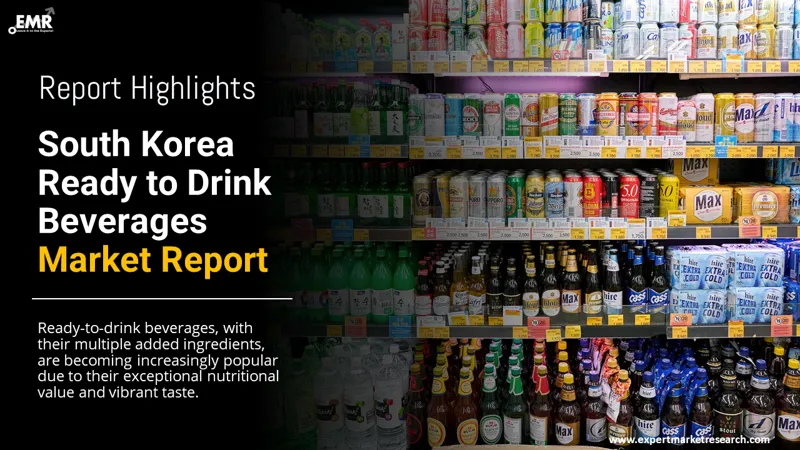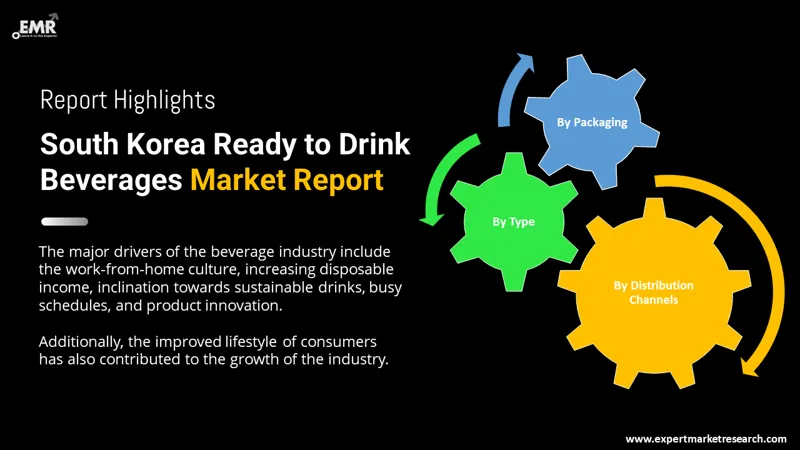
Consumer Insights
Uncover trends and behaviors shaping consumer choices today
Procurement Insights
Optimize your sourcing strategy with key market data
Industry Stats
Stay ahead with the latest trends and market analysis.
The South Korea Ready to Drink beverages market is further expected to grow at a CAGR of about 3.70% in the forecast period of 2026-2035. Work-from-home culture and increased demand immunity-boosting drinks are expected to drive the market growth exponentially during the forecast period.
Base Year
Historical Period
Forecast Period
Compound Annual Growth Rate
3.7%
2026-2035
*this image is indicative*
The demand for RTD beverages surged quickly as a result of the work-from-home culture during the lockdown. After and during COVID-19, consumers' greater knowledge and alertness led them to switch to more immunity-boosting RTD drinks. To meet the growing consumer demand, significant brands developed and introduced immunity-boosting beverages in a variety of tastes.

Read more about this report - REQUEST FREE SAMPLE COPY IN PDF
Ready to drink beverages are becoming more popular due to growing consumer awareness of the health risks associated with carbonated drinks. The key players' strategies for market expansion include tailoring health-beneficial items for women, children, and fitness enthusiasts. People have discovered ways to make leisure and social gatherings more enjoyable while working from home. Demand is driven by consumers who want beverages that fit into a busy lifestyle and maintain the premium quality and taste of the drinks.
Numerous innovative concepts, including infused and functional beverages, have been created in response to rising customer demand for tempting and pleasant flavours. Ready to drink beverages have multiple ingredients added to them, so consumers are becoming more interested in them due to their outstanding nutritional value and vibrant flavour.
Ready to drink beverages are drinks that are sold in single-use packaging and are ready to consume right after opening the packaging. Ready to drink beverages are now overtaking the marketplace as a result of growing consumer demand. These days, innovative packaging styles are available for all types of beverages, including juices, coffees, teas, alcoholic beverages, milk, and even health drinks.
By type, the South Korea ready to drink beverages market can be segmented into:
Based on packaging, the South Korea ready to drink beverages market can be divided into:
Based on distribution channel, the South Korea ready to drink beverages market can be bifurcated into:

Read more about this report - REQUEST FREE SAMPLE COPY IN PDF
To maintain a healthy lifestyle, consumers favour natural and organic products, driving manufacturers to produce numerous sugar-free, vegan, gluten-free, and organic ready to drink beverages. It has further led to the emergence of natural and health-beneficial ingredient cocktails with cheaper prices and easy accessibility, proliferating the increased investment in the sector.
The expansion of e-commerce coupled with the growth of ready to drink beverages, such as, 'Sansachun ’, a rice wine used for medicinal purpose to relieve anxiety and tension, has significant market value in South Korea. Similarly, 'bokbunja wine’ is made from bokbunja raspberry, a wild raspberry indigenous to South Korea, has therapeutic qualities prevents issues including frequent urination, early greying of hair, and hazy vision linked to altered liver and kidney functions, popularising healthy beverages in the market.
Positioning RTD beverages as recreational goods have attracted a younger demographic and secured the future of premiumization in RTD beverages, giving significance to the premiumization of beverages and aiding the emergence of various start-ups in the beverage sector. The fruit and vegetable RTD beverage sector is expanding owing to the surging demand of consumers for wholesome drinks. The growing health-conscious population is shifting towards cold-pressed drinks as they aim to eat right, choosing a balanced diet while lowering obesity. Moreover, the significant factor driving fruit and vegetable RTD beverage expansion is the nutritional value of these drinks, as they contain vitamins, minerals, and enzymes, thus boosting the RTD beverage market in South Korea.
As nutrients enriched flavoured water replaces fruit as a healthy alternative, consumers, and manufacturers are constantly investing in research and development to cater to this growing need. Moreover, the availability of various flavours and functional benefits has a positive impact while urging companies to innovate flavoured water to make it eco-friendlier and more sustainable. With an increased standard of living and rising disposable income, the inclination towards premium products is increasing. Thus, driving consumers, especially millennials and generation Z, to experiment with new flavours and product categories.
The growing popularity of gym, zumba, yoga and aerobics, together with the rising number of participants in half and full marathons, has further propelled the demand for energy drinks. Since sports drinks are high in chlorides, calcium, sodium, magnesium, and potassium , they are frequently consumed by fitness enthusiasts, athletes and sportspersons. Contrarily, energy drinks contain sugar and stimulant substances and provide customers with mental and physical stimulation while losing electrolytes and carbohydrates during strenuous physical activity.
Due to flavour familiarity and accessibility, ready to drink coffee demand is expected to increase quickly attributed to additional flavours and other healthy components, significantly accelerating the South Korea RTD beverages market growth. For example, Kanguru partnered with Binggrae and launched red ginseng, green tea, and many other energy drink flavours which attracted working-class and students in South Korea.
The report gives a detailed analysis of the following key players in the South Korea ready to drink beverages market, covering their competitive landscape, capacity, and latest developments like mergers, acquisitions, and investments, expansions of capacity, and plant turnarounds:
The comprehensive EMR report provides an in-depth assessment of the ready to drink beverages market based on the Porter's five forces model along with giving a SWOT analysis.




*While we strive to always give you current and accurate information, the numbers depicted on the website are indicative and may differ from the actual numbers in the main report. At Expert Market Research, we aim to bring you the latest insights and trends in the market. Using our analyses and forecasts, stakeholders can understand the market dynamics, navigate challenges, and capitalize on opportunities to make data-driven strategic decisions.*
Get in touch with us for a customized solution tailored to your unique requirements and save upto 35%!
The market is projected to grow at a CAGR of 3.70% between 2026 and 2035.
Work-from-home culture, product innovation, increasing disposable income, improved lifestyle, busy schedules, and inclination toward sustainable drinks are the major drivers.
Growing demand for eco-friendly and premium products, increasing health consciousness, and demand for immunity-boosting drinks among consumers are the key trends.
The dominant type of RTD beverages in the industry are tea and coffee, dairy based beverages, fruit and vegetable juices, sports drinks and energy drinks, and flavoured and fortified water, among others.
The leading distribution channels in the market are convenience stores, hypermarkets/supermarkets, online, specialty stores, and others.
The convenience of consumption of RTD beverages is one of the main draws for customers. Customers can now consume their beverages instantly, anytime, and anywhere. Additionally, premium brands use natural ingredients in their products and innovative packaging designs to attract customers.
The major players in the industry are Lotte Chilsung Beverage Co., Ltd., Maeil Co.Ltd, Dongsuh Companies, Inc., OKF Co., Hitejinro Co.,Ltd, and Yein T&G Inc., among others.
Explore our key highlights of the report and gain a concise overview of key findings, trends, and actionable insights that will empower your strategic decisions.
| REPORT FEATURES | DETAILS |
| Base Year | 2025 |
| Historical Period | 2019-2025 |
| Forecast Period | 2026-2035 |
| Scope of the Report |
Historical and Forecast Trends, Industry Drivers and Constraints, Historical and Forecast Market Analysis by Segment:
|
| Breakup by Type |
|
| Breakup by Packaging |
|
| Breakup by Distribution Channels |
|
| Market Dynamics |
|
| Trade Data Analysis |
|
| Competitive Landscape |
|
| Companies Covered |
|
Single User License
One User
USD 3,999
USD 3,599
tax inclusive*
Datasheet
One User
USD 2,499
USD 2,249
tax inclusive*
Five User License
Five User
USD 4,999
USD 4,249
tax inclusive*
Corporate License
Unlimited Users
USD 5,999
USD 5,099
tax inclusive*
*Please note that the prices mentioned below are starting prices for each bundle type. Kindly contact our team for further details.*
Flash Bundle
Small Business Bundle
Growth Bundle
Enterprise Bundle
*Please note that the prices mentioned below are starting prices for each bundle type. Kindly contact our team for further details.*
Flash Bundle
Number of Reports: 3
20%
tax inclusive*
Small Business Bundle
Number of Reports: 5
25%
tax inclusive*
Growth Bundle
Number of Reports: 8
30%
tax inclusive*
Enterprise Bundle
Number of Reports: 10
35%
tax inclusive*
How To Order

Select License Type
Choose the right license for your needs and access rights.

Click on ‘Buy Now’
Add the report to your cart with one click and proceed to register.

Select Mode of Payment
Choose a payment option for a secure checkout. You will be redirected accordingly.
Gain insights to stay ahead and seize opportunities.

Get insights & trends for a competitive edge.

Track prices with detailed trend reports.

Analyse trade data for supply chain insights.

Leverage cost reports for smart savings

Enhance supply chain with partnerships.

Connect For More Information
Our expert team of analysts will offer full support and resolve any queries regarding the report, before and after the purchase.
Our expert team of analysts will offer full support and resolve any queries regarding the report, before and after the purchase.
We employ meticulous research methods, blending advanced analytics and expert insights to deliver accurate, actionable industry intelligence, staying ahead of competitors.
Our skilled analysts offer unparalleled competitive advantage with detailed insights on current and emerging markets, ensuring your strategic edge.
We offer an in-depth yet simplified presentation of industry insights and analysis to meet your specific requirements effectively.
Share